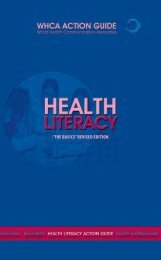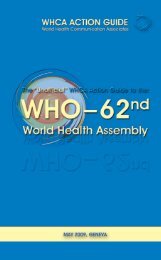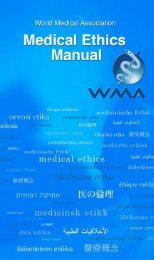Part 1 'the basics' - World Health Communication Associates
Part 1 'the basics' - World Health Communication Associates
Part 1 'the basics' - World Health Communication Associates
Create successful ePaper yourself
Turn your PDF publications into a flip-book with our unique Google optimized e-Paper software.
health literacy skills. One study applied an assessment tool to a pharmacy setting.<br />
It evaluated patient understanding of medications and adherence to prescribed<br />
regimens (Jacobson 2008). Additionally, the assessment tools:<br />
• Raise pharmacy staff awareness of health literacy issues.<br />
• Detect barriers that may prevent people with limited literacy skills from<br />
accessing, comprehending and using health information and services provided<br />
by the organisation.<br />
• Identify opportunities for improvement.<br />
Conducting an organisational assessment may also provide a baseline<br />
assessment prior to implementing an intervention. Jacobson identified nine<br />
key elements of an organisational health literacy intervention: management,<br />
measurement, workforce, care process, physical environment, technology, paperwork<br />
and written communications, culture and alignment. Evaluating these elements<br />
provides a comprehensive audit to assess congruence between patient, provider<br />
and organisational perspectives of health literacy. A follow-up assessment allows<br />
evaluation of the intervention’s impact on an organisation’s accessibility to those with<br />
limited health literacy.<br />
3.3 scorecards<br />
Some have proposed the development of health literacy scorecards for individual and<br />
system monitoring of literacy. The individual scorecard would identify a few key health<br />
indicators that are associated with a healthy physical and mental state. Individuals<br />
could rate themselves against a standard and agencies would be measured on how<br />
many of their users successfully achieved the score parameters. The challenge here<br />
will be to ensure that the variables selected truly reflect the health literacy status of<br />
individuals and agencies.<br />
3.4 a measure of health develoPment<br />
It has been suggested that population health literacy should be considered a measure<br />
of health development. A population health literacy index which measures the<br />
alignment between people’s skills and the health literacy friendliness of key systems<br />
and settings in which they need to function could provide a useful and unique picture<br />
of population health competence. Such an index could provide a new type of health<br />
index for societies that complements measures such as the disability adjusted life<br />
years (DALys) and morbidity and mortality data (Ratzan 2000; Kickbusch 2003).<br />
Section 3: How iS HealtH literacy meaSured? 19






